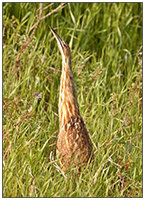Wading in the Water
It is that time of year when wading birds are in abundance. Below we have highlighted three striking, wading birds you can find in Michigan.Great Blue Heron
The largest of the North American herons, this bird wades slowly or stands statute like in shallow water hunting for its prey. The heron can be found in saltwater and freshwater habitats, from open coasts, marshes, riverbanks, lakes, backyard goldfish ponds, grasslands and agricultural fields.
Interesting facts:
- They can hunt day and night because of a high percentage of rod-type photoreceptors in their eyes that improve their night vision.
- Despite their large stature, measuring between 38.2 to 53.9 inches long they only weight around five to six pounds! This is due in part to their hollow bones.
- The oldest banded Great Blue Heron was 24 years old.
- In flight these birds make a “S” shape with their necks (pictured right) to become more aerodynamic; this is possible because of a specially shaped neck vertebrae. The special vertebrae also helps quickly strike prey at a distance.
- Great Blue Herons can be found in almost all of Michigan Audubon’s 19 bird sanctuaries.
- Conservation status: Least Concern. Populations are stable and have increased in Michigan and the surrounding areas due to the recovery of the beaver population, which has created numerous swamps and meadows well-suited for foraging and nesting.
.jpg)
This heron is relatively short and stocky, compared to other heron species. From a distance the bird looks dark and drab but once up close you can see striking small details. The heron displays a velvet-green back, rich chestnut body, piercing yellow eyes and a dark cap often raised in a short crest.
Interesting facts:
- The Green Heron is one of the world’s few tool-using bird species. It creates fishing lures with bread crusts, insects, earthworms, twigs, feathers and other objects, dropping them on the surface of the water to entice small fish.
.jpg)
- Because of its small stature (16-18 inches in length) is spends most of its time wading in shallow water. However, it does dive in deep water for prey and uses its partially webbed toes to swim to shore; it is a surprisingly graceful and effective swimmer.
- The Green Heron can be found on most of Michigan Audubon’s bird sanctuaries but is more heavily populated in sanctuaries in the Lower Peninsula.
- Conservation status: Least Concern. However, this heron has suffered a cumulative decline of 53 percent between 1966-2010 mainly due to habitat loss through draining and development of wetlands. It is hard for scientists to determine the extent the decline has on the population because the bird is naturally very solitary and widely dispersed.
This is a medium sized, stocky heron that stands around 23-33 inches in length and weighs only one to two pounds. It is extremely well camouflaged for its habitat and very secretive. The bittern is found in freshwater wetlands and marshes with tall vegetation.
Interesting facts:
- The American bittern has a very unique, deep, pumping sound that helps locate the bird easier than by sight. The call resembles, “oong-ka-choonk”. To hear the call click here.

- When approached the bittern prefers to freeze, stretch out its neck, bill pointed up and sway from side to side to mimic waving reeds (pictured right). This behavior earned it the nickname sky-gazer, look-up and stake-bird.
- American Bittern males are polygamous and will often have several nesting females on his territory.
- This bittern can be found on the following Michigan Audubon Sanctuaries:
- Phyllis Haehnle Memorial Sanctuary (Jackson, MI)
- Owastanong Island Sanctuary (Grand Haven, MI)
- Little Lake Sanctuary (Paradise, MI)
- Margaret Shroyer Sanctuary (Paradise, MI)
- Whitefish Point Bird Observatory (Paradise, MI)
- Brockway Mountain (Keweenaw, MI)
- Lake Bailey Sanctuary (Keweenaw, MI)
- Conservation Status: Special Concern (in Michigan), mainly due to extreme habitat loss.
Good luck this summer spotting these wading birds!
Your Bird Crew,



No comments:
Post a Comment